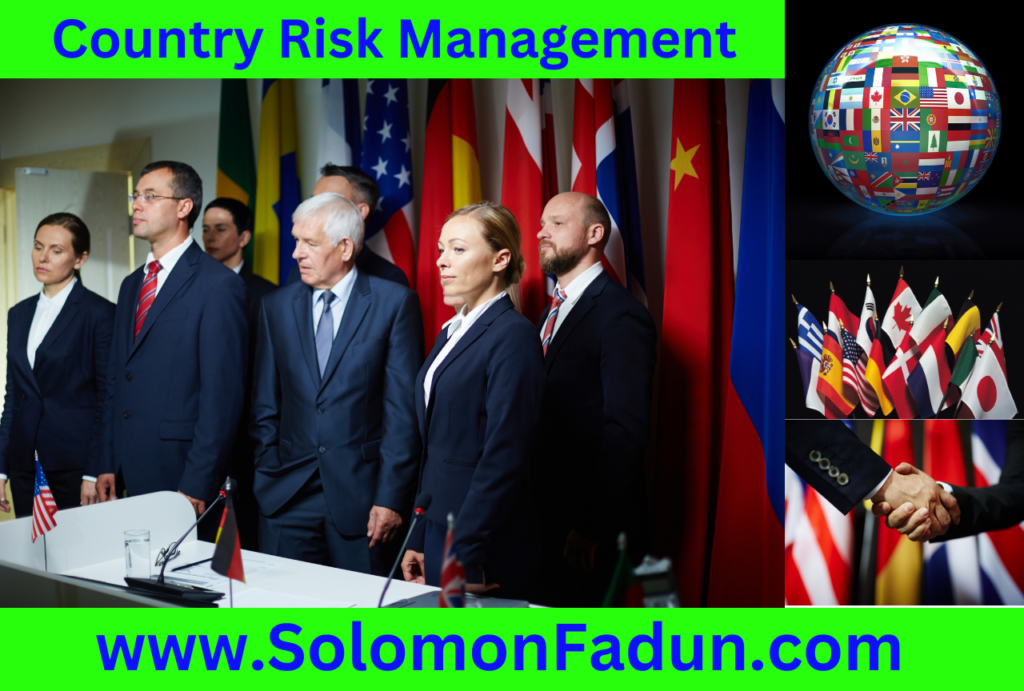Country Risk &
Country Risk Management

This post discusses country risk and country risk management. In this post, you will understand the meaning of country risk and the management of country risks.
WHAT IS COUNTRY RISK?
Country risk refers to the uncertainty associated with investing in a particular country and, more specifically, the degree to which that uncertainty could lead to investor losses. This uncertainty can arise from several factors, including political, economic, exchange-rate, or technological influences. Country risk, also known as sovereign or political risk, is sometimes called the risk that economic, social, and political conditions and events in a foreign country will affect an organisation’s current or projected financial situation or resilience.
Country risk connotes that a foreign government will default on its bonds or other financial commitments increasing transfer risk. Hence, the importance of country risk management. Country risk management in international business market because country risk is closely associated with strategic risk. Country risk comprises the various risks of investing in a foreign country, leading to either investment impairments or reductions in returns on investment (ROI). Both may arise from destructive and disruptive acts by others, such as violence, terrorism, war, strikes, infrastructure deficiencies, kidnappings, and physical phenomena.
IMPORTANCE OF COUNTRY RISK MANAGEMENT
The primary objective of managing country risk is to protect company investments in foreign markets and sustain acceptable investment returns. Foreign direct investment is not made through a regulated market or exchange, and longer-term investments are susceptible to the most significant potential risk of country risk. Country risk is critical to consider when investing in less-developed nations.
Political risks have increased due to the great turmoil created in financial markets. Consequently, political instability can affect investments in a country. Such country risk can reduce the expected return on investment (ROI) of securities issued within such governments or companies doing business in such countries. Investors may protect against some country risks, like exchange-rate risk, by hedging, but other risks, like political instability, only sometimes have an effective hedge. Thus, when analysts look at sovereign debt, they will examine the business fundamentals by reviewing what is happening in politics, economics, and the general health of the country issuing the debt.
To manage country risk, a multinational company should identify, measure, and monitor risks and control its level of exposure to foreign countries. The board of directors and senior management must ensure adequate oversight and maintain an effective system of controls over the company’s international activities commensurate with the activities’ volume and complexity.
Country risk management with multinational companies tends to suffer from one or more of three common defects:
1) Country risk and its varieties must be adequately defined, making it difficult to understand the nature and size of country risk exposures or set limits.
2) The estimation of country risk is distorted by a misleading method for allocating exposures to countries, that is, chalking as it is commonly known.
3) The absence of internally developed and, thus, transparent country risk models makes it difficult to respond adequately to the changing global macroeconomic landscape.
TYPES OF COUNTRY RISK
Country risk assessments can be classified into different categories based on the factors discussed earlier. Let us consider some of the most common and what they mean to determine how they impact multinational clients’ transactions.
1. POLITICAL RISK
Political risk determines a country’s political stability, either internally or externally. Political risk can affect a country’s attitude to meeting its debt obligations and may cause sudden changes in the foreign exchange market.
2. SOVEREIGN RISK
There is some crossover between political and sovereign risk, although the latter – also known as sovereign default risk – primarily examines debt. Sovereign risk measures the debt obligation of a government and its agencies and how the government anticipates fulfilling these obligations.
3. NEIGHBOURHOOD RISK
Neighbourhood risk, also known as location risk, may not be the direct fault of the country with which a company’s clients are dealing but is caused by trouble elsewhere.
4. SUBJECTIVE RISK
Subjective risk is about attitudes, including social pressures and consumer opinions on certain types of goods and organisations.
5. ECONOMIC RISK
Economic risk encompasses a wide range of potential issues that could lead a country to renege on its external debts and cause another currency crisis during a recession.
6. EXCHANGE RISK
Any predicted loss created by sudden changes in the exchange rate is generally covered under the exchange risk factor. This is another all-encompassing term, as a wide variety of factors can cause fluctuations in foreign exchange.
7. TRANSFER RISK
Transfer risk is another significant country risk assessment factor. This is where the host government becomes unwilling or unable to permit foreign currency transfers out of the nation.
RISKS ASSOCIATED WITH INTERNATIONAL BUSINESS
Country risk is a broad measure that captures the risks of conducting business activities in a foreign country. Country risk is closely related to strategic risk. Countries are vulnerable to three general types of crises: Sovereign default, exchange rate, and banking system. Currency devaluations, foreign exchange controls, and other political actions such as nationalisation or asset expropriation can affect domestic and foreign banks.
Using banks as a case study, risks associated with an international business include credit risk, interest rate risk, liquidity risk, price risk, operational risk, compliance risk, strategic risk, reputational risk, information and technology (IT) risk, cybersecurity risk, and emerging risks.
MANAGEMENT OF COUNTRY RISKS
Foreign investors may need clarification about the impact of geopolitics on investment and trade projects. They risk making sweeping decisions about their project, such as pulling out of specific regions or remaining figuratively paralysed. However, a three-step framework can assist companies in managing their country’s risk exposures.
Here are three significant steps of country risk management:
1. Analyse the current situation in the region
2. Identify the specific country risk events that might impact the company
3. Establish strategies to manage risks
FACTORS MULTINATIONAL FIRMS SHOULD CONSIDER WHEN FACED WITH HIGH-RISK COUNTRY RISK SITUATIONS
1. Empower local management
2. High risk of confiscation and discrimination emerges:
3. Consider the trends when assessing the risk
4. Conduct a post-mortem
See my video on Country Risk and Country Risk Management: https://youtu.be/o61pnqVpfAA

VIDEO TIMESTAMPS
00:00 – Introduction
01:01 – What is country risk?
03:13 – The importance of managing country risk (Importance of country risk management)
05:27 – Assessment of country risks
06:30 – Types of country risk
06:46 – Political risk
07:26 – Sovereign risk
08:00 – Neighbourhood risk
08:37 – Subjective risk
09:01 – Economic risk
09:52 – Foreign exchange
10:33 – Transfer risk
11:11 – Critical considerations of the management of country risk
12:42 – Risks associated with international business
31:47 – Country Risk Management
36:31 – Questions for boards on the management of country risk
37:30 – Factors multinational firms should consider for high-risk country risk situations
42:59 – Conclusion

